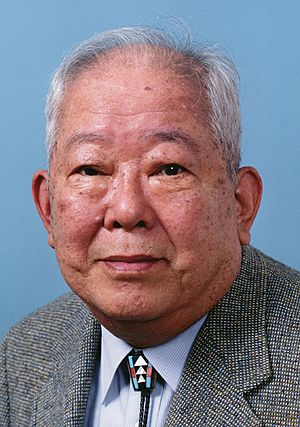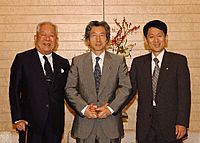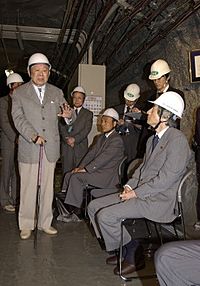Masatoshi Koshiba facts for kids
Quick facts for kids
Masatoshi Koshiba
|
|
|---|---|

Photograph of Koshiba published in 2002
|
|
| Born | September 19, 1926 Toyohashi, Aichi, Japan
|
| Died | November 12, 2020 (aged 94) Tokyo, Japan
|
| Nationality | Japanese |
| Alma mater | University of Tokyo University of Rochester |
| Known for | Astrophysics, neutrinos |
| Awards | Humboldt Prize (1997) Wolf Prize in Physics (2000) Nobel Prize in Physics (2002) |
| Scientific career | |
| Fields | Physics |
| Institutions | University of Chicago University of Tokyo Tokai University |
| Thesis | High energy electron-proton cascade in cosmic radiation (1955) |
| Doctoral advisor | Morton F. Kaplon |
| Other academic advisors | Shin'ichirō Tomonaga Takahiko Yamanouchi |
| Doctoral students | Yoji Totsuka Atsuto Suzuki |
| Other notable students | Takaaki Kajita |
Masatoshi Koshiba (小柴 昌俊, Koshiba Masatoshi, 19 September 1926 – 12 November 2020) was a Japanese physicist. He helped create the field of neutrino astronomy. This is a special type of astronomy that studies tiny particles called neutrinos.
Koshiba's work with the Kamiokande and Super-Kamiokande detectors was very important. It helped scientists find solar neutrinos, which are neutrinos that come from the Sun. This work also helped solve a big puzzle called the "solar neutrino problem."
In 2002, Masatoshi Koshiba won the Nobel Prize in Physics. He shared the prize with Raymond Davis Jr.. They won for their amazing work in astrophysics, especially for finding cosmic neutrinos.
He was a senior advisor at the International Center for Elementary Particle Physics (ICEPP). He was also a professor at the University of Tokyo.
Contents
Early Life and Education
Masatoshi Koshiba was born in Toyohashi, Japan, on September 19, 1926. His father was a military officer. When he was three, his mother passed away. His father then married his mother's older sister.
He grew up in Yokosuka and finished high school in Tokyo. He first wanted to study German literature. However, he ended up studying physics. A teacher's comments encouraged him to choose physics.
He earned his first degree from the University of Tokyo in 1951. Later, he received his PhD in physics from the University of Rochester in New York in 1955.
Discoveries and Research


Koshiba started his career at the University of Chicago in 1955. He later became a professor at the University of Tokyo. From 1987 to 1997, he also taught at Tokai University.
In 2002, he won the Nobel Prize in Physics. This was for his important work in astrophysics and finding cosmic neutrinos. He shared the prize with Raymond Davis Jr. and Riccardo Giacconi.
Koshiba first studied cosmic rays. In 1969, he started working on electron-positron colliders. He helped with the JADE detector in Germany. This work helped confirm the Standard Model of particle physics.
The Kamiokande Experiment
Koshiba, along with Masayuki Nakahata and Atsuto Suzuki, designed the Kamiokande experiment. This experiment was built to look for something called "proton decay." This was a prediction from a theory called "grand unified theories."
They did not find proton decay. However, Koshiba realized the detector could be used for something else. It could detect neutrinos! He changed the project to focus on neutrinos.
Through this experiment, Koshiba and Raymond Davis Jr. confirmed a prediction. They showed that neutrinos are made during the nuclear fusion reactions inside the Sun. But these experiments found fewer neutrinos than expected. This puzzle was called the solar neutrino problem.
Solving the Neutrino Puzzle
The solar neutrino problem was eventually solved by "neutrino oscillations." This means neutrinos can change from one type to another. An even bigger version of Kamiokande, called Super-Kamiokande, confirmed this. Koshiba's student, Takaaki Kajita, led this project.
In 1987, the Kamiokande detector found neutrinos from a supernova explosion. This supernova, called SN 1987A, happened outside our Milky Way galaxy. It was in the Large Magellanic Cloud. This discovery was a big step. It helped make neutrino astronomy a real field of study.
In 1996, the team built the Super-Kamiokande detector. It was much larger and more sensitive. With this new detector, scientists showed strong evidence. They proved that neutrinos change types as they travel. This explained the solar neutrino problem. The earlier detectors could only see one type of neutrino, not all three.
Koshiba was also a member of the Board of Sponsors for the Bulletin of the Atomic Scientists. He was a foreign member of the Bangladesh Academy of Sciences.
Personal Life
Masatoshi Koshiba married Kyoto Kato, who was an art museum curator. They got married when he returned to Japan in the late 1950s. They had a son and a daughter.
He passed away on November 12, 2020, in Tokyo. He was 94 years old.
Awards and Honors
Masatoshi Koshiba received many important awards and honors for his work.
Awards
- 1987 – Asahi Prize
- 1987 – Nishina Memorial Prize
- 1997 – Humboldt Prize
- 2000 – Wolf Prize in Physics
- 2002 – Nobel Prize in Physics
- 2002 – Panofsky Prize
- 2003 – Benjamin Franklin Medal in Physics
Honors
- 1985 – Order of Merit of the Federal Republic of Germany
- 1997 – Order of Culture
- 2002 – Honorary citizenship of Suginami
- 2002 – Honorary doctor of Meiji University
- 2002 – Elected Fellow of the American Physical Society.
- 2003 – Grand Cordon of the Order of the Rising Sun
- 2003 – The Koshiba hall was built at the University of Tokyo's School of Science. This was to celebrate his Nobel Prize.
- 2003 – Honorary citizenship of Tokyo
- 2003 – Emeritus Professor of the University of Tokyo
See also
 In Spanish: Masatoshi Koshiba para niños
In Spanish: Masatoshi Koshiba para niños
- Institute for Cosmic Ray Research
- Kamioka Observatory
- List of Japanese Nobel laureates
- List of Nobel Laureates affiliated with the University of Rochester
- List of Nobel laureates affiliated with the University of Tokyo
- University of Rochester

